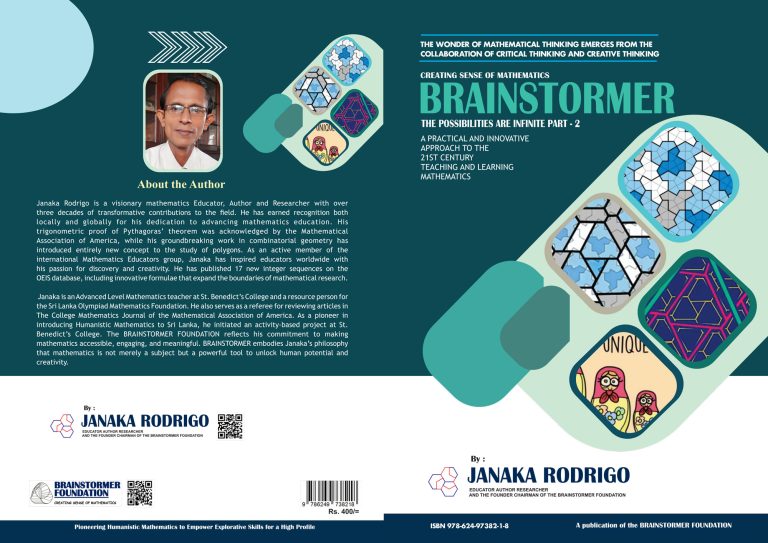PUBLICATIONS

BRAINSTORMER : THE POSSIBILITIES ARE INFINITE 2
FOREWORD
It is with great admiration that I professionally endorse BRAINSTORMER, a mathematics resource book that benefits a broad audience including school students, teachers and academic researchers through its comprehensive and step-by-step approach to mathematics education.
In the 21st-century, the context of interdisciplinary learning enables students to achieve high-profile educational outcomes by promoting critical thinking. This book emphasizes the creation of mathematical models and formulation of computer programs to solve complex problems. The book follows a unique methodology starting with fundamental concepts including drawing figures and provides step-by-step guidance to ultimately reaching to a greater understanding of mathematics.
A testament to the author’s innovative thinking is the publication of 17 new sequences on the Online Encyclopedia of Integer Sequences (OEIS), reflecting groundbreaking contributions to mathematics. These sequences not only enhance the field but also inspire students to think creatively and develop critical thinking and problem-solving skills.
The book further features seven articles on novel approaches to various mathematical topics. These articles are invaluable for understanding contemporary developments in mathematics. The quality of this author’s contributions has been internationally recognized as evident by his invitation as a referee for the prominent academic journal, the College Mathematics Journal of the Mathematical Association of America.
Additionally, BRAINSTORMER introduces the Humanistic Mathematics Activity-Based Project, a pioneering initiative that effectively generates student interest in mathematics and motivates them to pursue higher academic goals. The criteria for selecting activities and the examples provided in the book offer excellent guidance for teachers to design their own activity sessions.
While it is practically impossible to deliver mathematics education to perfection due to resource limitations and the constraints of exam-oriented Syllabi, BRAINSTORMER provides practical guidance to learn mathematics in an interactive and meaningful way. This is not merely a vision, but a reality demonstrated through the exemplary commitments of its Founder Chairman.
I highly recommend BRAINSTORMER for its innovative contributions to mathematics education and its ability to inspire learners, educators, and researchers alike. It is a significant asset to the mathematics field and a commendable effort toward elevating the standards of mathematics education.
Senior lecturer and a Former Head of the Department of Mathematics
University of Kelaniya
Sri Lanka
January 26, 2025
PREFACE
Most of us are born lateral thinkers, naturally inclined to use nontraditional and unconventional approaches to problem-solving. This type of thinking is crucial for developing creativity and exploratory skills. However, many lose their lateral thinking abilities in schools and universities due to the adoption of vertical thinking, which emphasizes strict adherence to rules and focusing on a single answer. This approach limits our brains to a fixed frame, giving very little opportunity to enhance
exploratory skills in mathematics.
In my first prime document “The Possibilities are Infinite”, I have provided numerous examples where lateral thinking is essential to transforming the reader into an explorer. Preparing students’ mindsets before they enter secondary education is crucial for them to fully benefit from this document. Therefore, I prepared the second prime document, “Maths Projects for Grades 8, 9, 10, and Ordinary Level Students,” which introduces maths activities for students up to the ordinary level standard.
This third document BRAINSTORMER consists of a new concept of combinatorial geometry, 17 new sequences in mathematics published on the OEIS, and 7 new proofs. Among these is a fully trigonometric proof of Pythagoras’ theorem that does not rely on the properties of similar triangles, and the first-ever single proof of both the Sine Law and the Cosine Law. Related articles not only introduce novel approaches but also guide readers in formatting manuscripts to international standards. Additionally, it includes a pioneering initiative Humanistic Mathematics Activity-Based Project and establishing the Brainstormer Foundation for the development of mathematics education. This document aims to provide significant evidence that supports my vision articulated in the first document. The positive feedback from senior lecturers at leading universities, who reviewed the first document, further validates this vision. As a result, users can be confident in the value of the information provided in the first document, which aim to transform the current system of mathematics education into a more contextual teaching and learning process. This transformation holds the promise of producing mathematicians who can appreciate the importance of mathematical issues, view the world through the lens of mathematics, describe both physical activities and the wonders of nature in mathematical terms, tackle global challenges, and create their own challenges and conjectures that extend beyond conventional human understanding. I believe that the provided mathematical models and computer programs will be helpful for the students who are doing ICT as a subject and academics in their research within the software field, ultimately fulfilling the goals of 21st century mathematics education.
I extend my sincere gratitude to the board of editors of the Online Encyclopedia of Integer Sequences for recognizing the importance of new concepts and assisting in drafting my submissions to international standards. My heartfelt thanks go to the editors of the Mathematical Association of America journals for reviewing my submissions and providing valuable feedback. Special thanks to Rev. Bro. Director Dr. Pubudu Rajapaksha for his support in initiating the Humanistic Mathematics Activity-Based Project at the college, and to Dr. (Mrs.) Kissani Perera for graciously providing the FOREWORD for the BRAINSTORMER.
Founder Chairman
BRAINSTORMER FOUNDATION
Sri Lanka
January 27, 2025
New concept in Combinatorial Geometry
- Partitioning the set of vertices of a convex polygon into non-intersecting polygons.
Sequences published on Online Encyclopedia of Integer Sequences (OEIS)
- A350116 – Number of ways to partition the set of vertices of a convex (n +8) – gon into 3 nonintersecting polygons.
- A350248 – Triangle read by rows T(n,k) is the number of noncrossing partitions of an n – set into k blocks of size 3 or more, n > = 0, 0 < = k < = floor (n/3)
- A350286 – Number of different ways to partition the set of vertices of a convex (n + 11) – gon into 4 nonintersecting polygons.
- A350303 – Number of ways to partition the set of vertices of a convex (n + 14) – gon into 5 nonintersecting polygons.
- A350599 – Number of ways to partition the set of vertices of a convex n – gon into nonintersecting directed polygons.
- A350640 – Minimum lcm of the part sizes of a partition of n into parts of size 3 or more.
- A347862 – Total number of polygons left out in all partitions of the set of vertices of a convex n – gon into nonintersecting polygons.
- A351103 – Total number of polygons left over with maximum number of sides when partitioning the set of vertices of a convex n – gon into nonintersecting polygons.
- A352477 – Number of different ways to partition the set of vertices of a convex n – gon into 4 intersecting polygons.
- A352474 – Number of different ways to partition the set of vertices of a convex n – gon into 3 intersecting polygons.
- A352611 – Number of different ways to partition the set of vertices of a convex n – gon into 5 polygons.
- A352900 – Number of different ways to partition the set of vertices of a convex n – gon into intersecting polygons.
- A357603 – Number of different pairs of shortest paths in an n X n lattice going between opposite corners in opposite direction and not meeting at their middle point.
- A357760 – Number of different pairs of shortest grid paths joining two opposite corners in opposite order in an n X n X n grid with middle point on the paths as a common point.
- A358481 – Number of different pairs of shortest grid paths joining two opposite corners in opposite order in an n X n X n grid without having middle point on their paths as a common point.
- A362207 – Number of unordered triples of shortest nonintersecting grid paths joining two opposite corners of an n X n X n grid.
- A360444 – Number of ways for two nonintersecting, unordered pairs of shortest grid paths to cross over between two opposite corners in an n X n grid without intersecting opposite paths at their middle points.
Mathematical Models and Computer Programs in Combinatorial Geometry
- Mathematical Model of the sequence A360444.
- Python Code of the Mathematical Model of A360444.
- Mathematical Model of ordered triplets ( An open challenge to create a computer program and obtain integer outputs)
New proofs and totally different approaches in other fields of mathematics
- Geometrical proof of the sum of infinite series Cot-1 3 + Cot-1 7 + Cot-1 13 + …….. converges to π /4.
- Geometrical proof of the sum of infinite series Cot-1 2 + Cot-1 8 + Cot-1 18 + …….. converges to π /4.
- Geometrical proof of the sum of infinite series 1/1.2 + 1/2.3 + 1/3.4 + …… converges to 1.
- Geometrical proof of sum and the product of three tangents of a triangle are equal in the case of an obtuse-angled triangles.
- The Inclusion-Exclusion Principle in geometrical approach of completing square in Quadratics.
- Fully trigonometric proof of Pythagoras theorem without applying properties of similar triangles.
- Simultaneous Single Proof of the Sine Law and Cosine Law.
21st Century Teaching and Learning Mathematics
- Humanistic Mathematics Activity-Based Project.
- Brainstormer Foundation
ANNEXTURE
- Geometric Abstract Art Lesson Plan.

